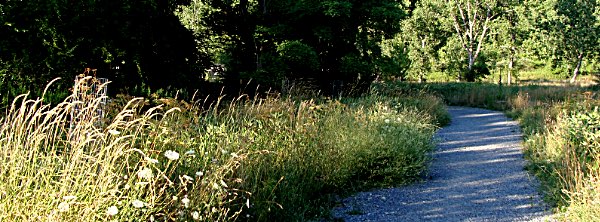- By Dan Veaner
- News
 Print
Print 
Salt Point will soon be wheelchair accessible. The main gravel loop walk in the park will be converted this summer to a hard-surface walkway that can accomodate wheelchairs. The Lansing Town Board Wednesday discussed a plan to recover the coarse gravel loop walk that spans the lakefront portion of Salt Point from the handicapped parking area to the north, and loops along Salmon Creek to the parking lot at the entryway of the park.
"We're trying to make Salt Point more handicap accessible," said Councilwoman Katrina Binkewicz. "We have had some complaints about the instability of the loop trail. Cricket (Highway Superintendent Charlie Purcell) said limestone dust would have a very reasonable cost. The Highway Department could apply it and it would be long-lasting."
Salt Point is across Salmon Creek from Myers Park. It is a nature park optimized for walking, and is infused with Lansing history going back to the late 19th century. Cayuga Lake Salt Company was formed on the point in 1891. The company a method of evaporating the brine from a salt well on the property. By 1893 the plant had a capacity of 140 tons daily and employed 100 persons. The Refinery continued to grow and many people from Syria came to work in the plant and live on the hill above the point. The refinery became the International Salt Company and produced table salt and industrial salt until 1962, when it was consolidated with the Watkins Glen plant and the vacuum pans were loaded on flat cars and taken by railroad to the new location. As the plant was being demolished, it caught on fire and burned to the ground in the summer of 1962, at which point it was sold to the New York State Department of Environmental Conservation (DEC).
But the DEC did not have resources to maintain the park, and it degenerated to a lawless haven for parties, drinking, drugs, dumping, and other crime. Referred to as 'UC Point' after Utica Club beer, a popular pilsner that appeared at the end of prohibition, and has been popular for 70 years. In 2006 the Town of Lansing signed a 25 year lease with the DEC that turned the management, though not ownership, of the park to the Town. After an initial investment the management has come under the purview of the 'Friends of Salt Point', a volunteer group that has made significant improvements, many of which with the assistance of the Town Highway Department. They have included a massive cleanup of the park, blocking auto traffic, creating walking paths, the establishment of a non-motorized boat launching area, picnic area, and informational kiosk, as well as signs and invasive species removal, and the addition of an osprey nesting platform.
The limestone dust is applied in much the same way as concrete, and will create a hardened surface. While not as robust as blacktop, it will provide a lasting surface with the help of volunteers who, Binkewicz said, would remove weeds.
"It works pretty well," said Councilman Doug Dake. "You can still pick it apart with a shovel. It's more permeable than blacktop or concrete, yet it still sheds water."
Supervisor Ed LaVigne said the lease with the DEC does not allow the Town to create permanent structures or infrastructure.
"I think this is about the best way we can do it for everybody and still comply with our lease," LaVigne said. "This falls, I believe under the category of not permanent. Also it should need the least amount of maintenance. It is still a hard surface so you can have wheelchairs on it. So this is about the best balance we can have."
Binkewicz said the pathway will have a side trail leading to the beach area, plus another area by a bench facing the water, where a Little Free library is.
"There is an ADA requirement in terms of width that is at least 40 inches, and every 75 feet you have to have a landing so they can pass each other," added Lansing Planning Consultant Michael Long. "If you make it five feet wide the whole way, that's your minimum."
The improvement is estimated to cost $6,000. LaVigne noted that the Board was slated to add $15,000 to Pathways Capital Reserve this year, and said that after spending the money on improving the path the remaining $9,000 would be added to the reserve, bringing it up to $24,000 to be spent on future town pathways acquisitions and improvements.
v14i17



